I‘m on a tare. I arrived in Moscow only 8 days (7 nights) after crossing the Russian/Mongolian border some 5,500 kilometres to the east of here. Of the 7 nights that have passed since entering Russia I have spent all but 3 of them sleeping on trains. That fact goes some way to explaining how I got here as quick as I did, but without feeling like I’ve seen little of Russia on this my first visit to the country (I don’t). But I’m finally here in Moscow and back in Europe proper having crossed the Asia/Europe boarder shortly after leaving Yekaterinburg yesterday.
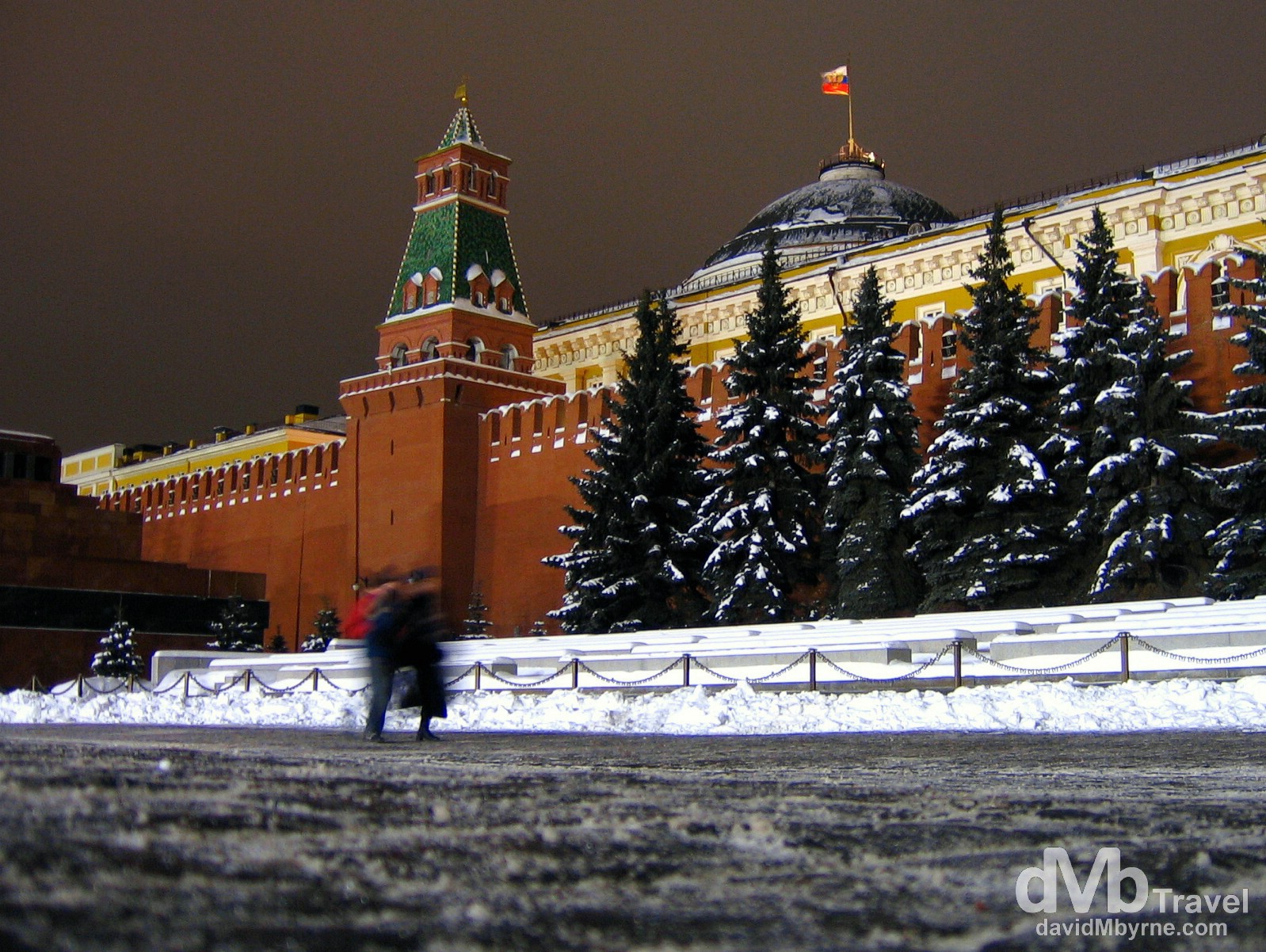
A portion of the walls of the Kremlin as seen from Red Square, Moscow (![]() ), Russia. February 25, 2006.
), Russia. February 25, 2006.
– Bob Schaffer
Moscow
Moscow is, of course, the Russian capital. It first became the central power in Russia in 1430 under Ivan III, a.k.a. Ivan the Great. It remained the capital until 1712 when Peter the Great moved it to the newly created Saint Petersburg, my next stop. It finally reverted back to the capital, this time the capital of the USSR, in 1918 following the success of the Lenin-led 1917 Communist Revolution. It has been the center of world communism ever since. The city, which takes its name from the river which flows through it, is the political, economic, financial, educational, and transportation center of the biggest country in the world. That I did know. But I was surprised to learn that Moscow, with 10.2 million inhabitants, is also the biggest and most populous city in Europe not to mention, & at 800 roubles ($30) for a dorm room in the Traveller’s Guesthouse, one of its most expensive.
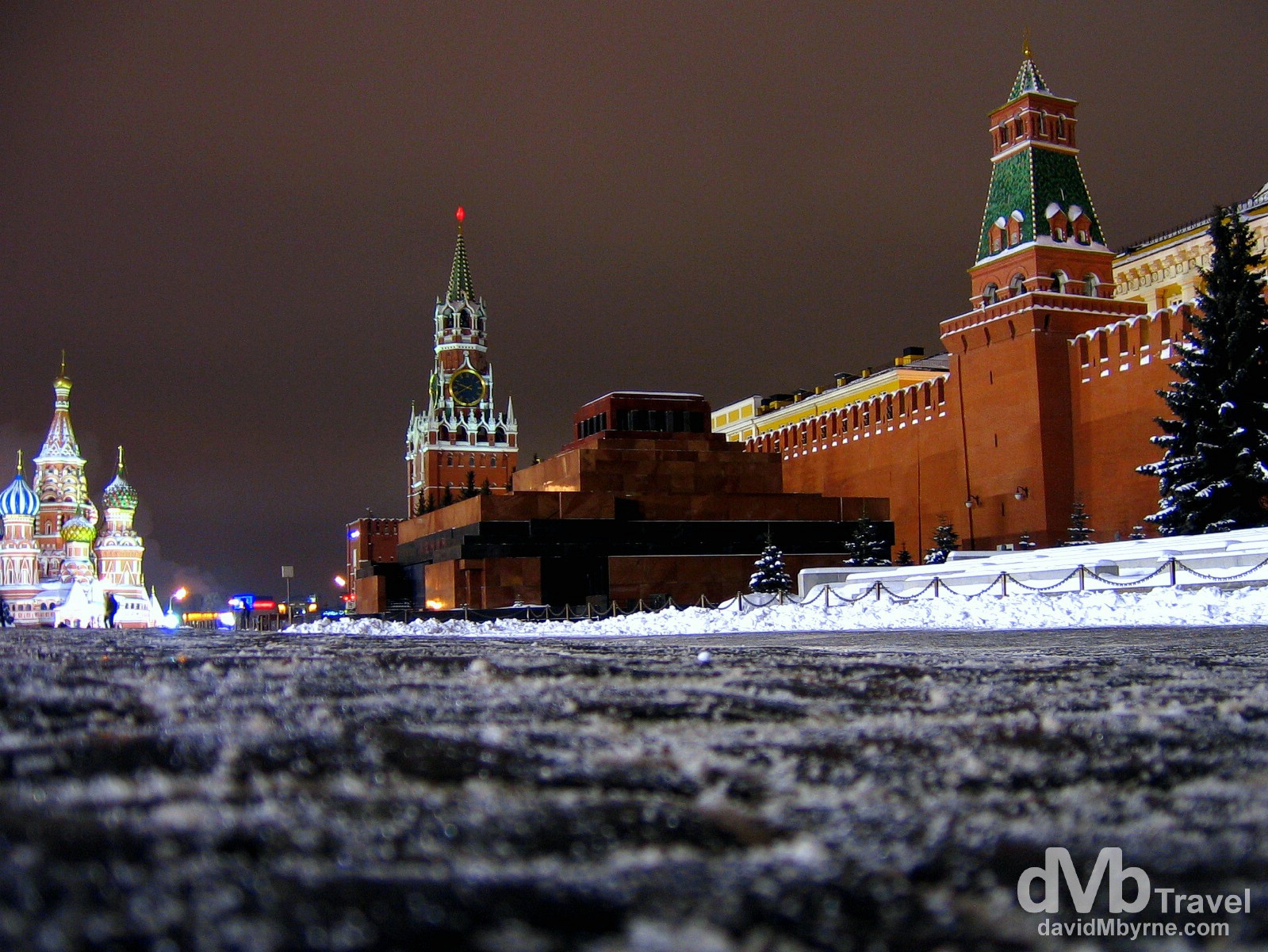
Red Square on a bitterly cold February night. For me getting to stand in Red Square was what visiting Moscow was to be all about. All that Communist Cold War footage of the Red Army marching through what looked to be a square of endless expanse had me perceiving it to be a massive expanse. Well it isn’t like that at all. It’s quite small, much smaller than I expected. But that’s not to say there isn’t anything to see. There is. There’s the imposing Spasskaya Tower & blood-red walls of the Kremlin, the GUM Department Store, iconic St. Basil’s Cathedral (left), and Lenin’s Mausoleum (centre). All are impressive, world famous attractions. But I couldn’t get over the compactness of it all. Moscow, Russia. February 25, 2006.
Lenin’s Mausoleum
Lenin, the father of Russian communism, is today Red Square’s number one resident and has been since his death in 1924. There have been rumblings for a while that there is no place for the Lenin Mausoleum, and all it signifies, in the new Russia, so much so that Boris Yeltsin, the first post-USSR president of the Russian Federation, intended to close the tomb and bury Lenin next to his mother in Saint Petersburg where, apparently, Lenin wished to spend eternity. Needless to say relocating Lenin hasn’t happened to date and as of now it looks like he isn’t going anywhere anytime soon.
Visiting the Lenin Mausoleum yielded a similar experience to visiting the mausoleums of the other two famous Marxists heavy hitters, Mao Zedong in Beijing, China, & and Ho Chi Minh in Hanoi, Vietnam. By all accounts, Lenin’s mausoleum provided the inspiration for both of those mausoleums, violating both Mao and Uncle Ho’s desire to be cremated (I’m sensing a trend here). With all three now Marxists now embalmed, it’s a tough call as to which is more wax like. Thanks to my experiences in Beijing and Hanoi before it, the procedure for paying one’s respects to Lenin here in Moscow were familiar to me one – pay a ludicrous fee to have someone ‘look after’ your bag, join a somber line of other pilgrims/sightseers/mourners and follow, without stopping, a well worn path that brings you in one entrance of the mausoleum, past the chamber with the man himself on display (draped in communist red velvet) and finally out another entrance on the far side. However, the added attraction of the Lenin Mausoleum was that the exit brings you out at a closed-off section of Red Square at the base of the Kremlin walls where other greats of Russia’s past, political and non-political, are buried including Yuri Gagarin, the first man in space. You still have to keep moving as you peruse the granite delights on display here but if you concentrate hard enough you will recognise the final resting places of other famous USSR leaders such as Brezhnev and Joseph Stalin, the Soviet leader during WW II who, rumour has it, had Lenin’s brain removed in a fanciful attempt to study the ‘pure communist’ brain.
Moscow Metro
The Moscow Metro System was Stalin’s showcase, a vain attempt in the 1930s to openly celebrate socialist achievement with the biggest and longest tunneling project ever attempted by man. Not one person questioned the initial cost or the subsequent upkeep and now it costs billions of rubles a year for maintenance while costing only a few rubles a ride (in the early 90’s Boris Yeltsin tried to raise the fare but the public furor was so great they backed down). While Stalin may have questions to answer over other building projects he oversaw as part of his push to modernise the city, very few, if any, question the building of the metro system, one that carries on average 8.2 million passengers a week, has over 150 stations, and with a train typically every 2 minutes it lays claim to be one of the best, if not the best, in the World. And as mentioned it’s cheap, in a city where not too many things are.
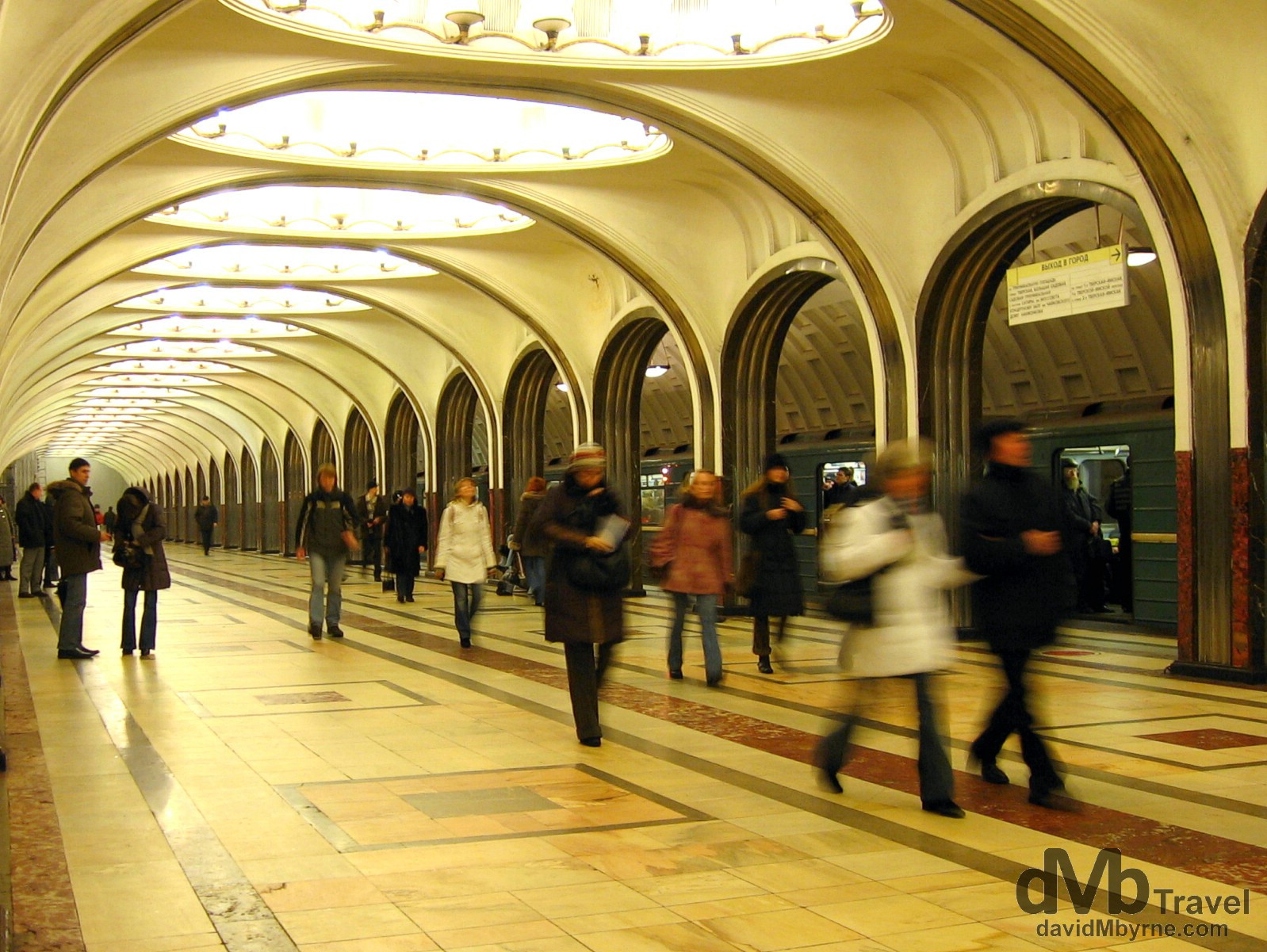
Some of the older stations of the Moscow metro system were built to double as war bunkers & are so deep that you cannot see one end of the escalator to the other. Some of the stations are decked out like art galleries or museums with ornate museum-like interiors, statues and wall murals. The stations on the Koltsevaya (or ring) line are designed to different themes containing beautiful examples of socialist realist art. This is The Art Deco Mayakovskaya Metro Station on the Zamoskvoretskaya line, built as part of the metro second phase of construction and opened in 1938. I spent a few hours last night travelling around the various stations taking pictures. Of course one is not actually allowed to photograph the metro stations (something about national security) and as I’m not exactly gifted with the ability to snap discreetly I drew quite a few curious looks from interested locals and more than a few raised eyebrows from the authorities. They made themselves know to me on a few occasions but the worst I got was a stern “het” (no), a shake of the head & a wave of a hand. Mayakovskaya metro station. Moscow, Russia. February 25, 2006.
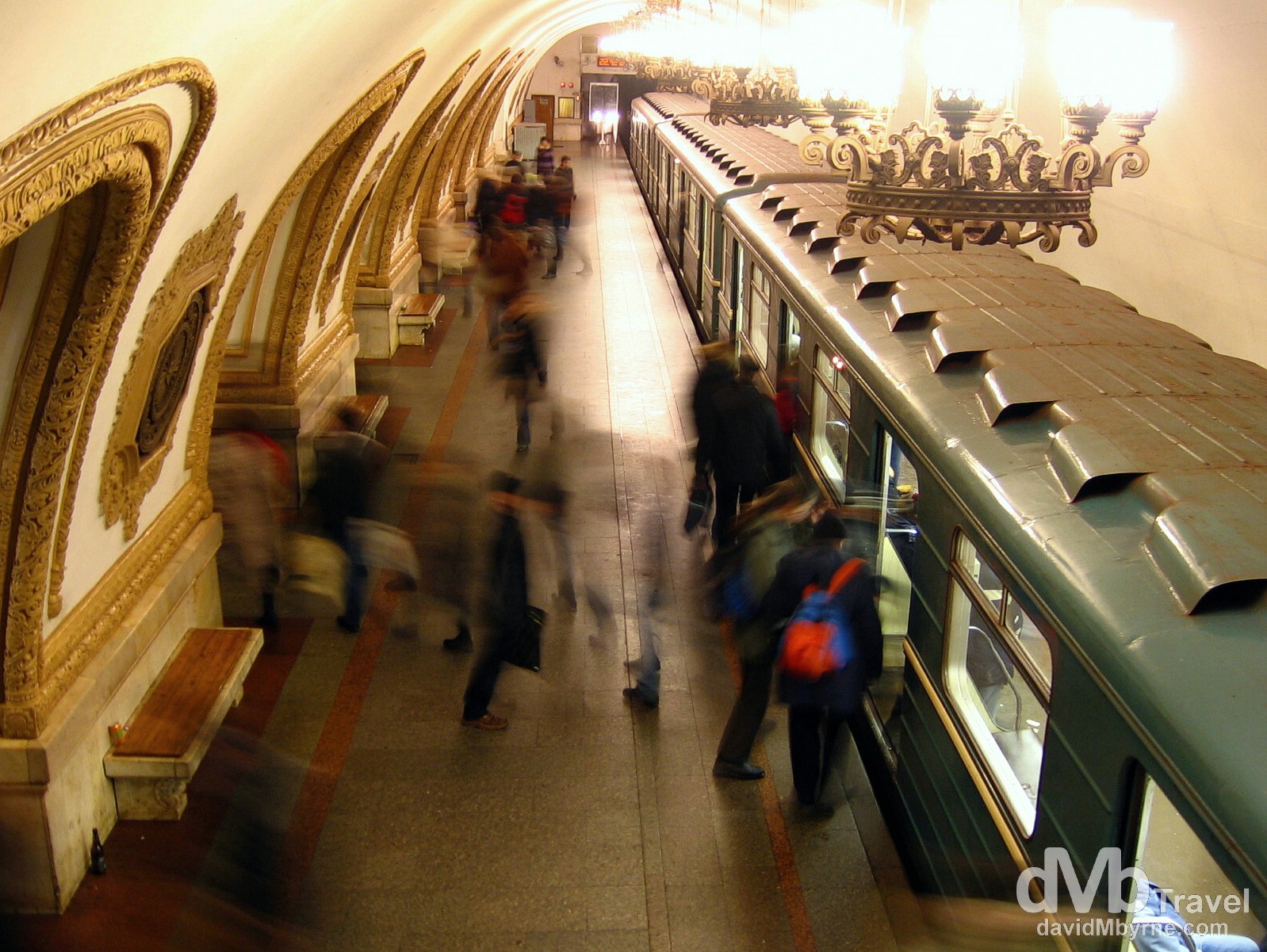
Kievskaya subway station, Moscow, Russia, as captured from an elevated overpass connecting neighbouring platforms. February 25th 2006.
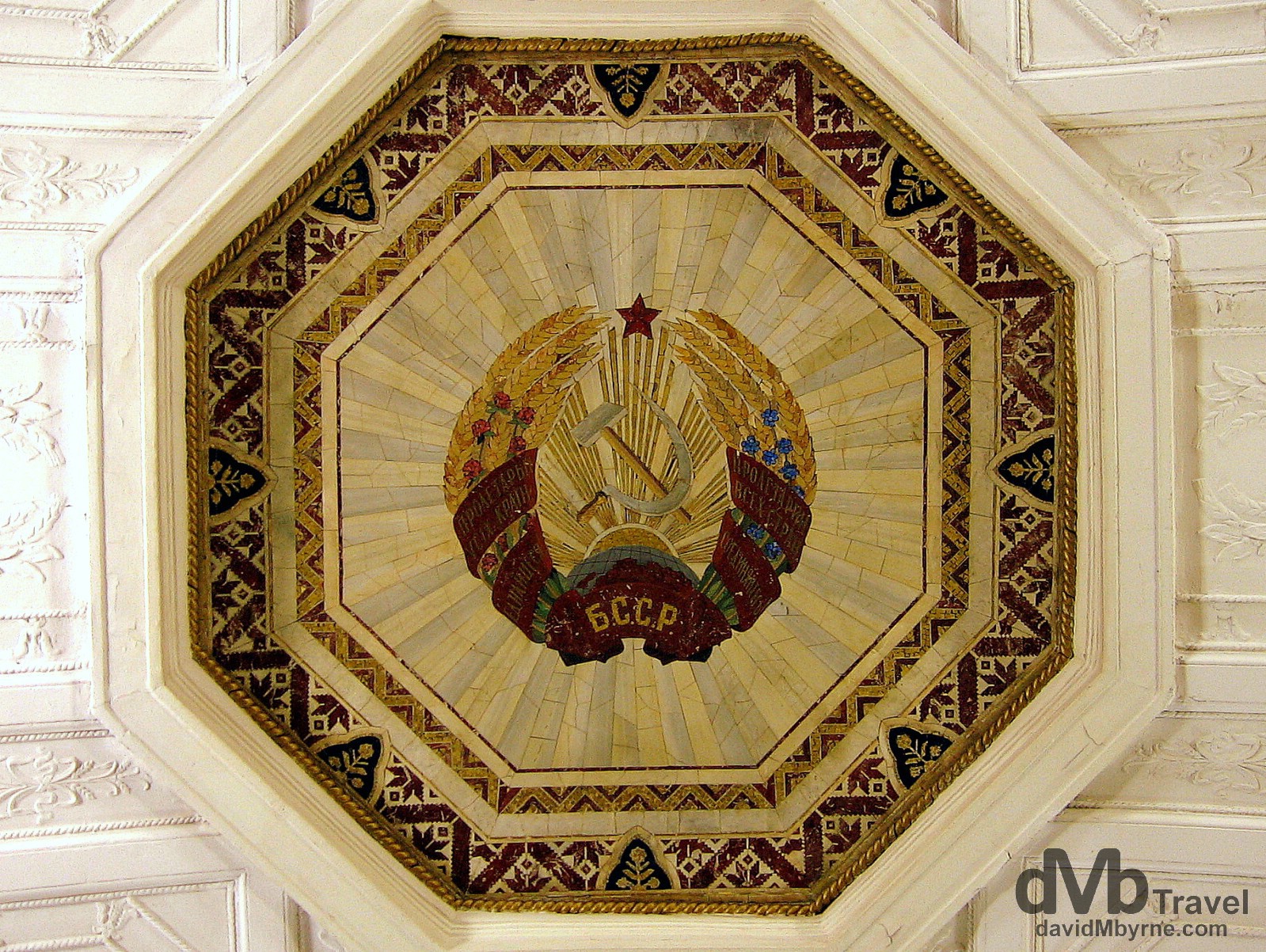
A Soviet-era mosaic on the roof of a station of the Moscow metro system. Moscow, Russia. February 25, 2006.
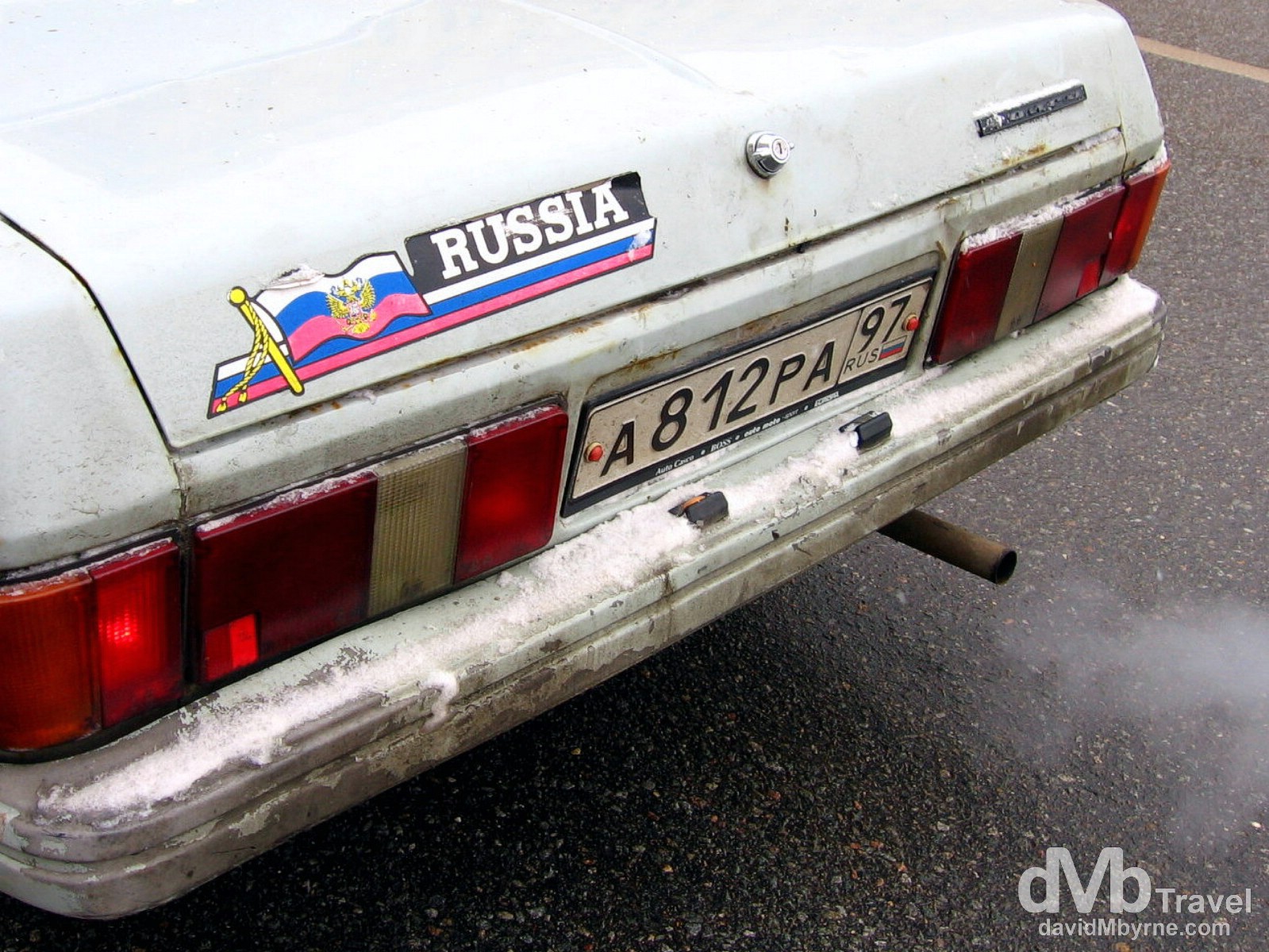
At least it’s not a Lada or, surprisingly for Moscow, a fancy high-end German sedan. This was taken outside the Lubyanka Building, the headquarters of the dreaded KGB. The building today houses the KGB’s successor organisation, the Federal Security Bureau (FSB). Lubyanka Square. Moscow, Russia. February 26, 2006.
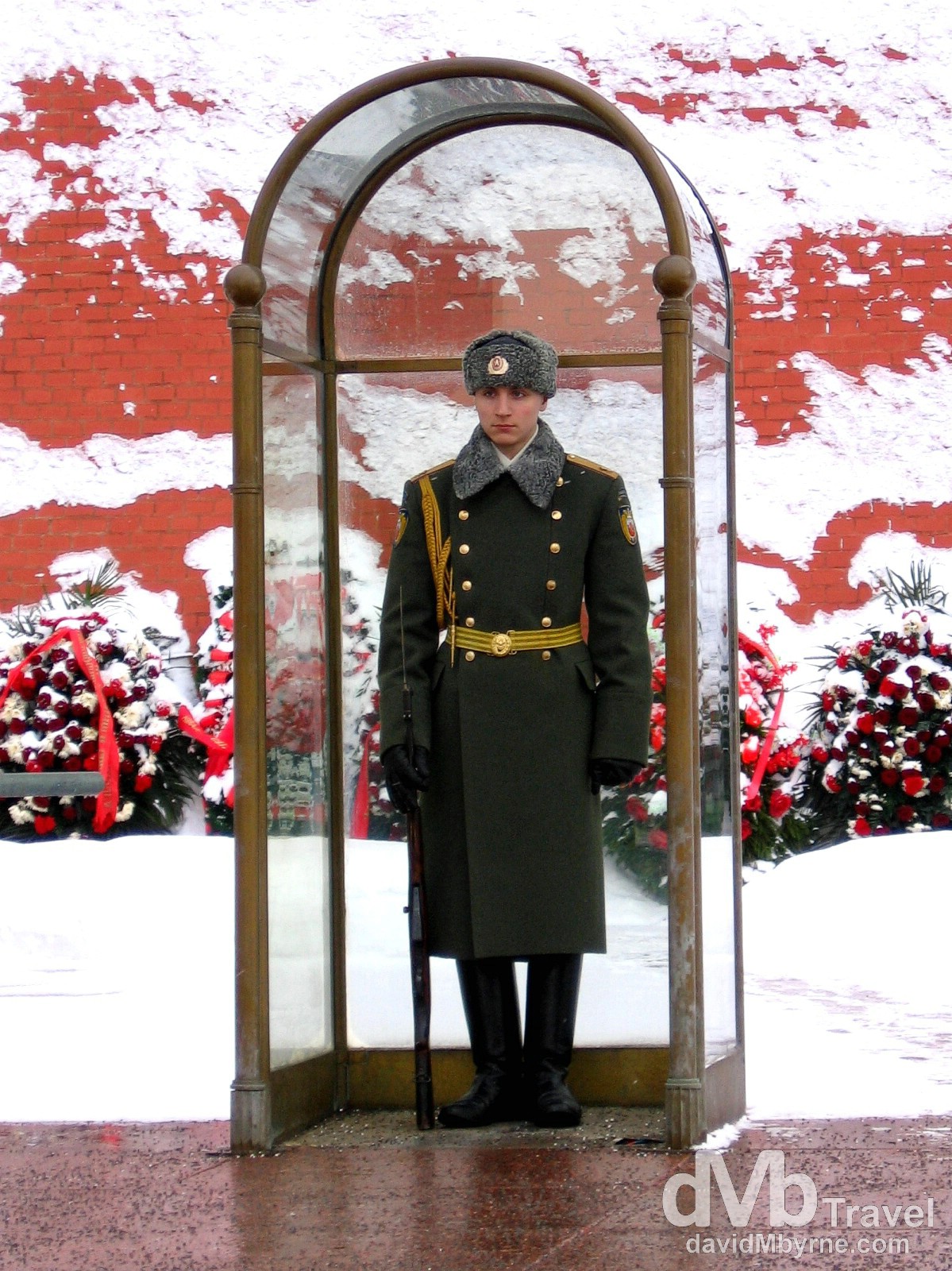
A guard at the Tomb of The Unknown Soldier at the base of walls of the Kremlin in Alexandrrowsky Garden (Alexandrrowsky Gardens). Russia lost more soldiers – a lot more soldiers – than any other nation fighting in World War II, or the Great Patriotic War of 1941-1945 as it is known by Russians. The memorial dedicated to the Soviet soldiers killed during the war – inscribed “1941 – To Those Who Have Fallen For The Motherland – 1945” – is located at the base of the Kremlin Wall. It contains the requisite eternal flame and a series of 13 granite stones, each encapsulated with soil and labelled with the names of the so-called World War II hero cities, cities whose citizens put up fierce resistance to the advancing Nazis during the war – Leningrad, Kiev, Odessa, Sevastopol, Minsk, Kerch, Novorossiysk, Tula, Brest and Volgograd, the plate for which had its name changed from Stalingrad, the city’s name during World War II. Alexandrrowsky Garden, Moscow, Russia. February 25, 2006.
Sparrow Hills

Sparrow Hills is an elevated hill on the right bank of the Moscow River that offers nice views of the city. The hills, immortalized by many Russian poets and writers, have popular ski fields and there is even a full sized ski jump. Once here you can’t miss the Moscow State University building (not shown here). Built by German prisoners of War, it’s the biggest of Stalin’s impress-the-world skyscrapers and it looks like one huge Gothic pile of concrete reaching into the clouds. What you can see in this picture is the Luzhniki Stadium (formerly, the Lenin Stadium), the centerpiece for the 1980 Summer Olympics. I hung around here for a while watching the light die over Moscow before haggling with a souvenir seller for a mini matryoshka (Russian) doll set – I could have went for a set of dolls depicting world leaders, ex-American Presidents or, of course, Lenin and his cronies. I didn’t. A section of Moscow as seen from Sparrow Hills overlooking the city. Moscow, Russia. February 26, 2006.
Moscow Kremlin
Kremlin means citadel (a walled city) in Russian and many medieval Russian town had one with Moscow’s being the biggest & today the most well-know. It was first built in the 1150s and grew with the importance of the Moscow princes, most of whom were crowned within its walls. In the 1320s it became the head of the Russian Orthodox Church. Between 1475 and 1516 Ivan III, Russia’s first Tsar, brought master builders from all over the World to supervise the construction of new walls, towers and cathedrals. This extravagance vastly changed the layout of the Kremlin interior and earned him the title of Ivan the Great.
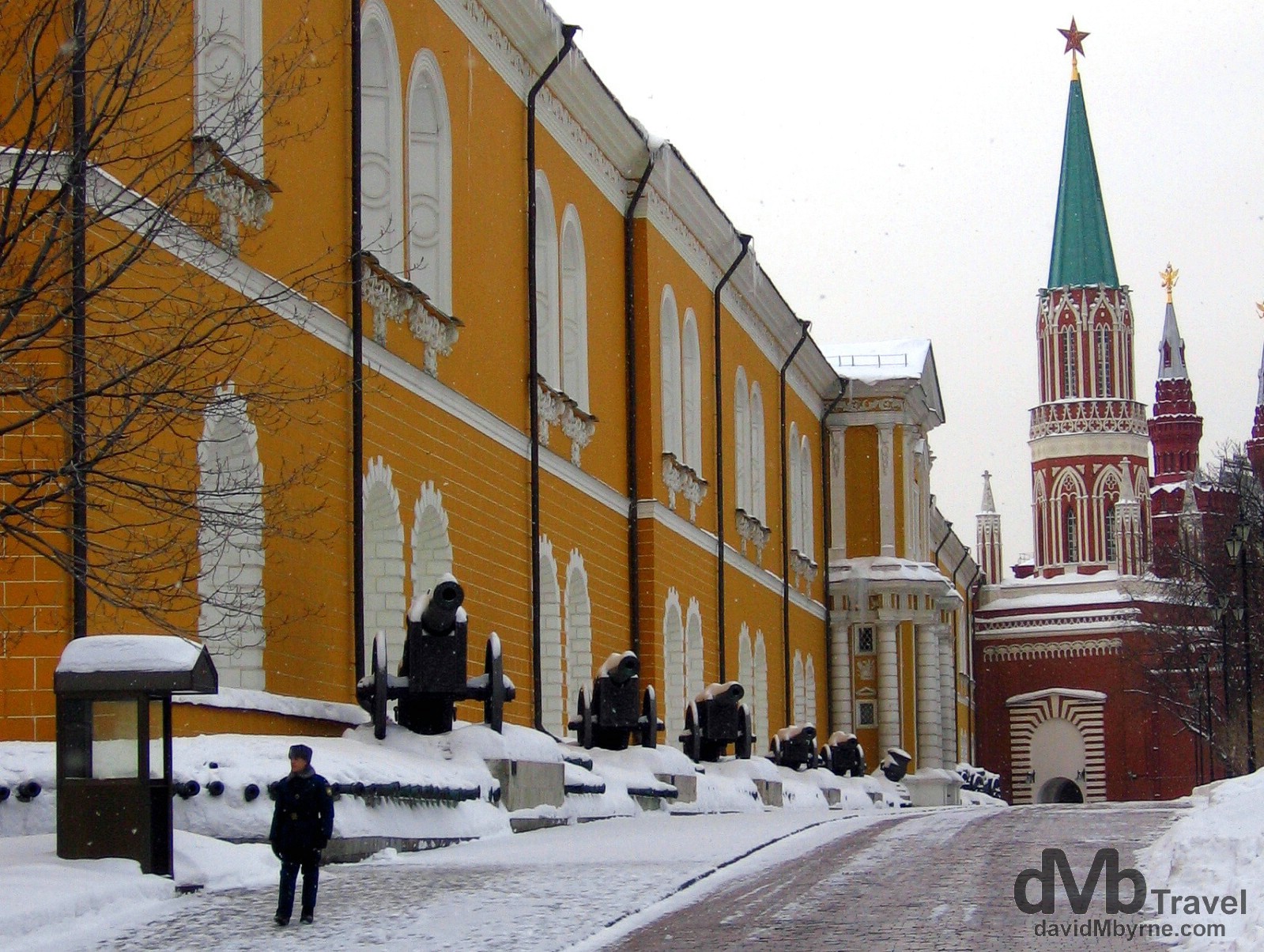
The Moscow Kremlin, a symbol of power and intrigue recognised the world over. I suspect in the days of the Cold War, when international spies risked their lives to get in here, that the security was no less intense. But then again one mustn’t forget, a tourist attraction aside, this is the seat of the Russian Government and the nerve centre of Russian politics. It just didn’t feel like it. These days you don’t need to risk your life to get in here. Nope, all you have to do is stump up the fee which, like everything else in Moscow, is overpriced. Just stay on the paths, OK? The guards are grumpy. You’ve been warned. In the grounds of the Kremlin, Moscow, Russia. February 26, 2006.
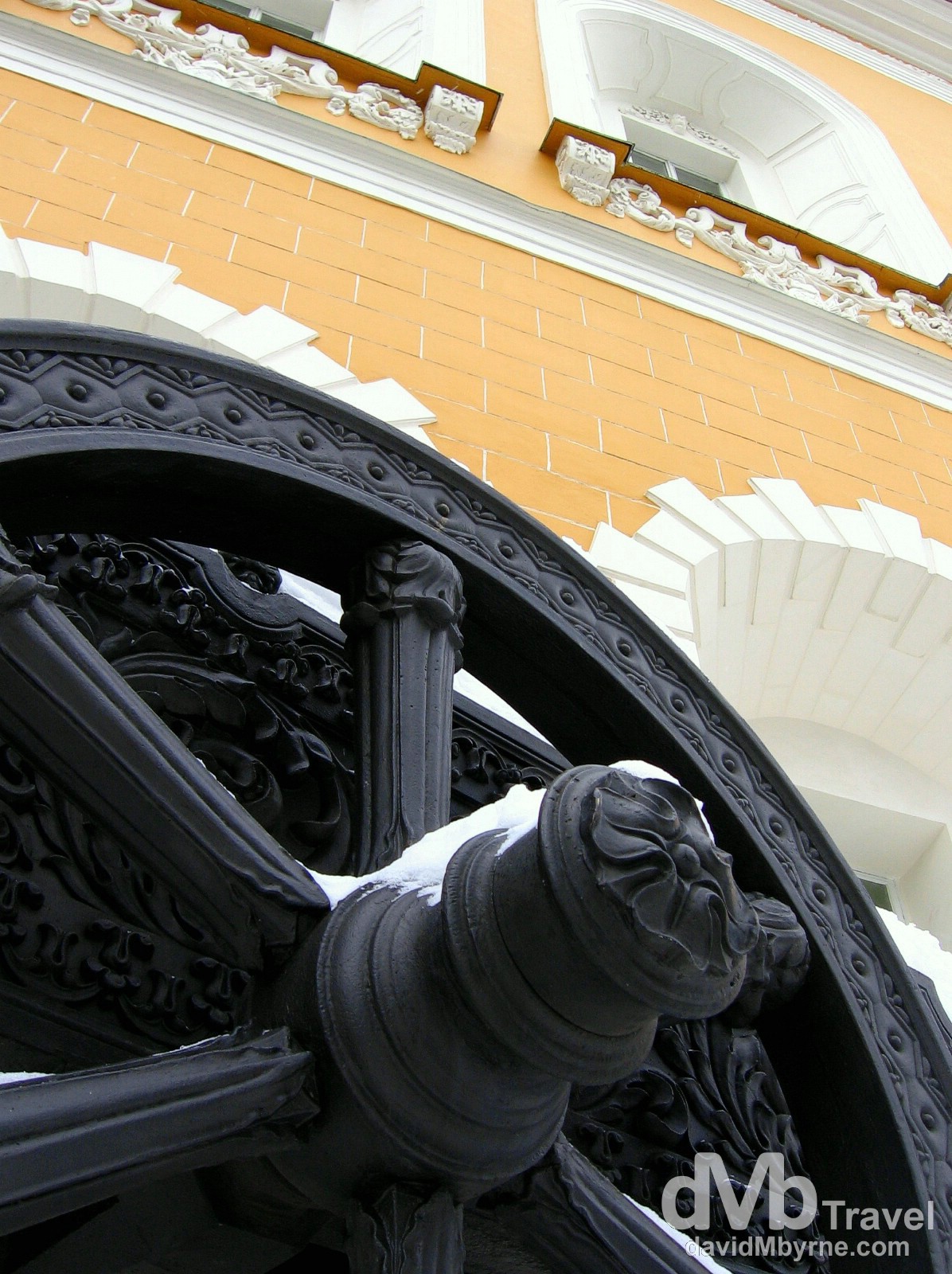
Ornamental Napoleonic cannons line the inside walls of the Kremlin. They looked nice, if a little harmless, positioned at the base of the yellow walls covered in a sprinkling of snow. In the grounds of the Kremlin in Moscow, Russia. February 26th, 2006.
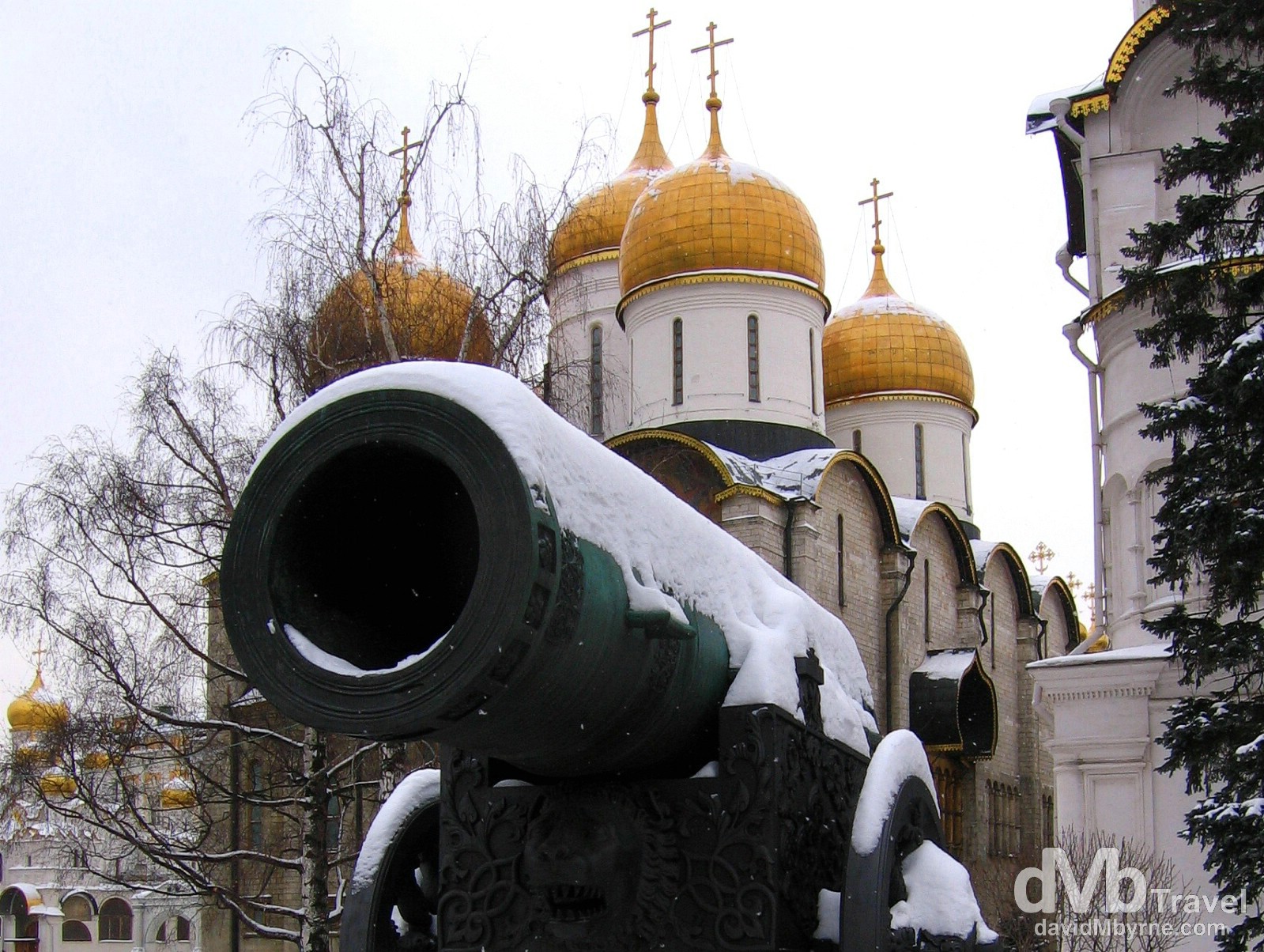
I guess this cannon, The Tsar Cannon, was supposed to scare people. And it might have have done just that had it ever been fired – it never was. It epitomizes the Russian penchant for big things – bigger was not only better, it was glorious. Cast in 1586 it’s still, I think, the largest canon in the world, it would no doubt would create quite a wallop were it ever to be fired up. But that’s not likely to happen. Now it’s just used as a photo opportunity for tourists like me. Speaking of photo opportunity, right beside the cannon is the world’s biggest bell, the Tsar Bell, a 202-tonne whopper that cracked before it ever rang. I’m sensing a bit of a pattern here. Both front the gorgeous Assumption Cathedral, the most impressive of the Moscow Kremlin’s buildings. In the grounds of the Kremlin in Moscow, Russia. February 26, 2006.
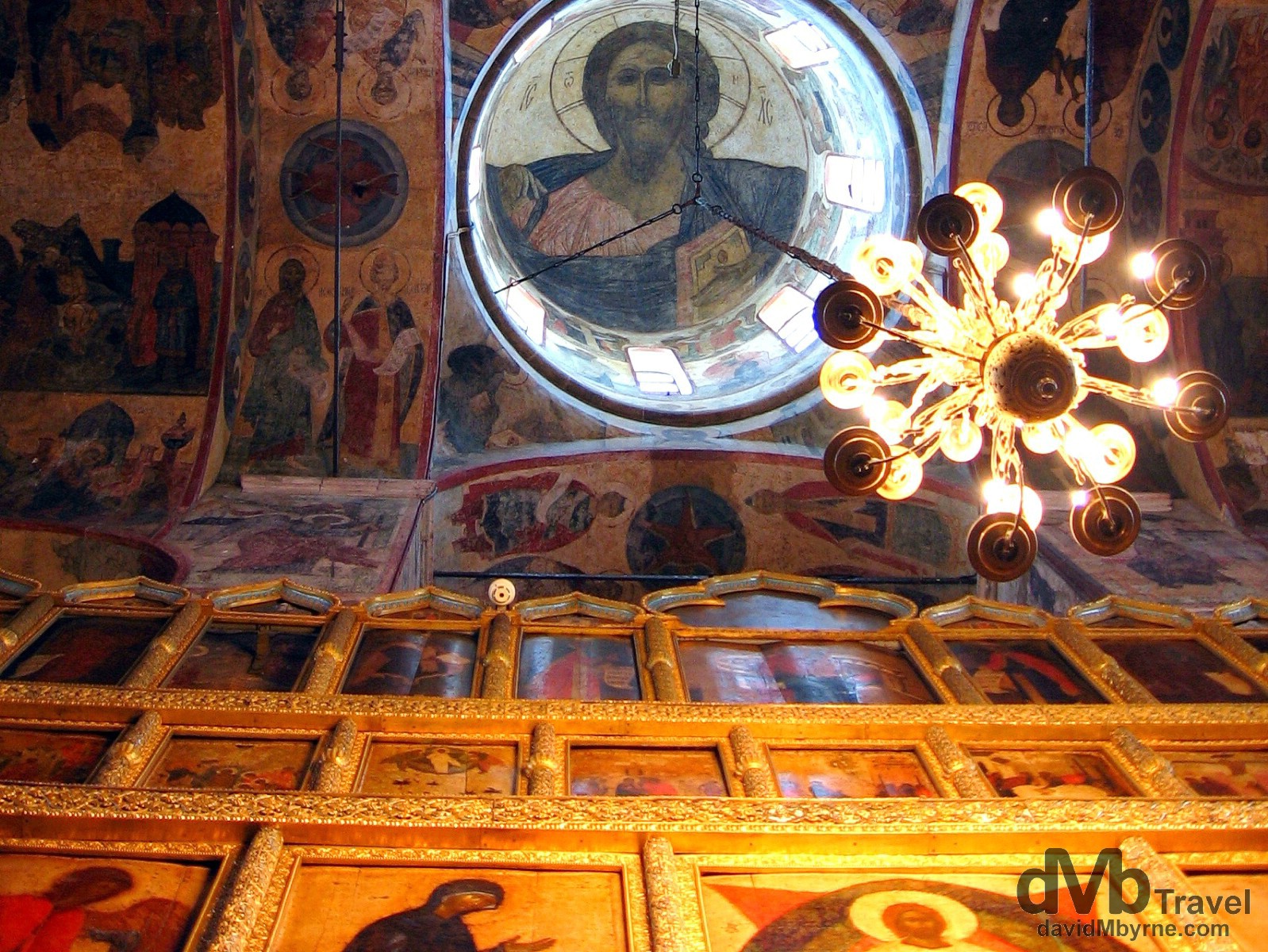
Iconostasis in the interior of the 15th century Uspensky Sobor, the Assumption cathedral, the most impressive of the Kremlin buildings & the focal church of pre-Revolutionary Russia – the cathedral saw the coronation of Ivan IV, aka Ivan the Terrible, in 1547 and every Russian emperor from 1721 until the Communist revolution of 1917 (after which all religious practice was prohibited) & it was also the burial place of heads of the Russia Orthodox Church from the 1320’s until 1700, with their tombs scattered around the church. There is a legend that in the winter of 1941, when the Nazis had already reached the threshold of Moscow, Joseph Stalin secretly ordered a service to be held in the Cathedral to pray for the country’s salvation from the invading Germans. The cathedral was only returned to the Russian Orthodox Church in 1990 following the fall of the USSR and today it’s open to the public as a museum and a place of worship. The interior of the cathedral is famous for housing the tombs of various heads of the Russian Orthodox Church and for the amazing iconostasis, walls of icons and religious paintings separating the nave from the sanctuary in a church of Eastern Christianity, some of which are seen here. The Assumption Cathedral in the grounds of the Moscow Kremlin, Russia. February 26, 2006.
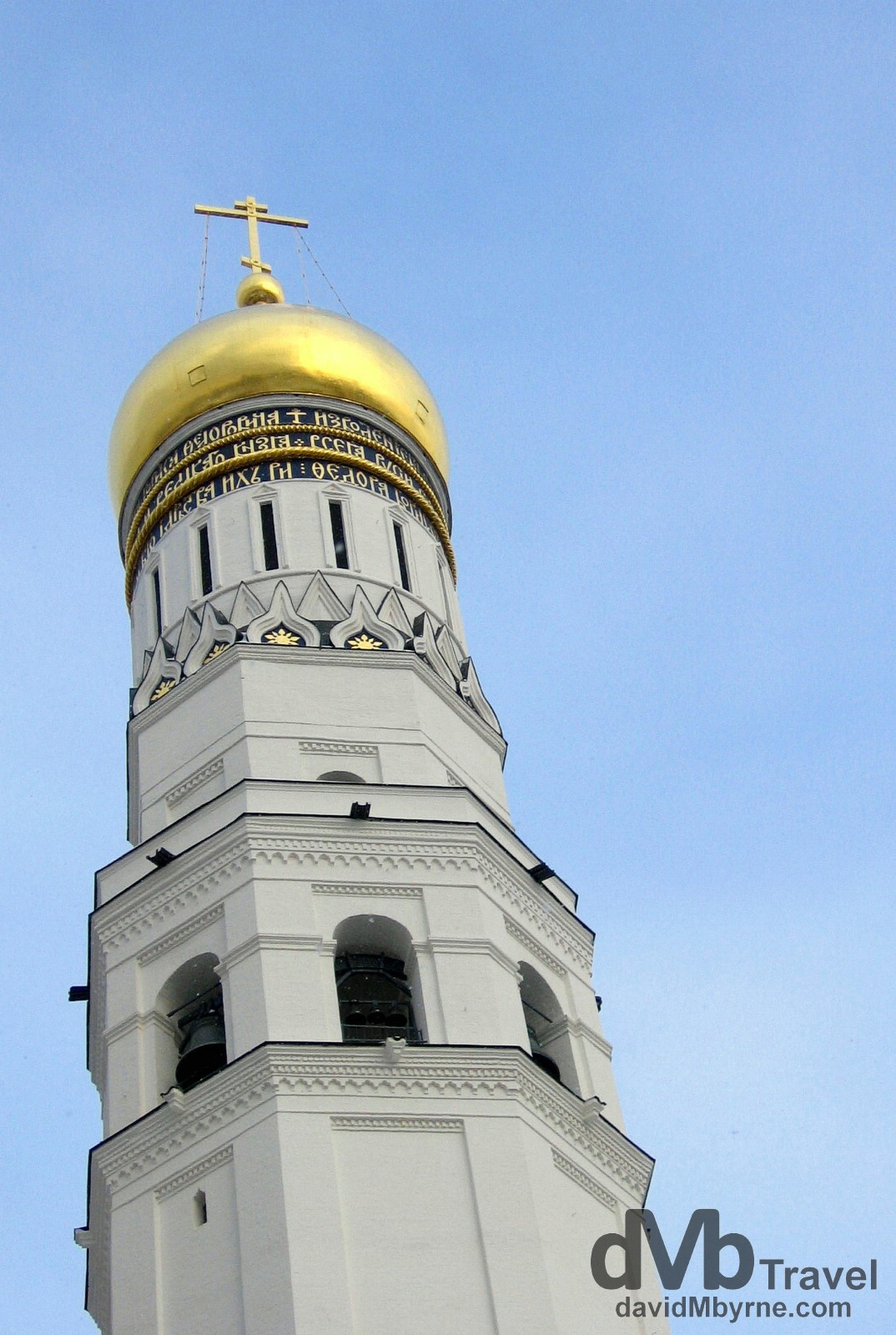
So what happens if you go to the trouble of getting celebrated architects and engineers from all over the world to come to Moscow and entrusted them with the task of reconstructing the buildings of the Kremlin from scratch in the traditions of Russian architecture? You get a tower named after you of course. This is The Ivan the Great Bell Tower and at 81 metres it is the tallest building in the Moscow Kremlin complex. It was built for the nearby Assumption, Archangel and Annunciation cathedrals, which do not have their own belfries, and is said to mark Moscow’s precise geographic centre. The Ivan the Great Bell Tower of the Moscow Kremlin. Moscow, Russia. February 26, 2006.
Red Square || The Red Centre
Moscow was/is more than just Red Square and for any visitor it should be. That said, even after spending time looking at the walls of the Moscow Kremlin from the Moskvoretsky most (bridge) over the Moscow River (& nearly freezing to death in the process); even after searching for a Pushkin statue; even after looking at a few Russian Orthodox churches on ul Varvarka; even after paying a visit to Sparrow Hills for a views of the city; even after touring the accessible parts of the Kremlin; even after riding the metro system to ogle at some of the system’s impressive stations; even after going to the Lubyanka area of the city to see the old KGB stomping ground; and even after taking a look at the redevelopment of the Bolshoi theatre. Even after all of that we still seemed to gravitate back to Red Square. That’s just the way it was for us in Moscow. It – Red Square – is the centre of everything in the capital. The centre of the city. The centre of the nation.
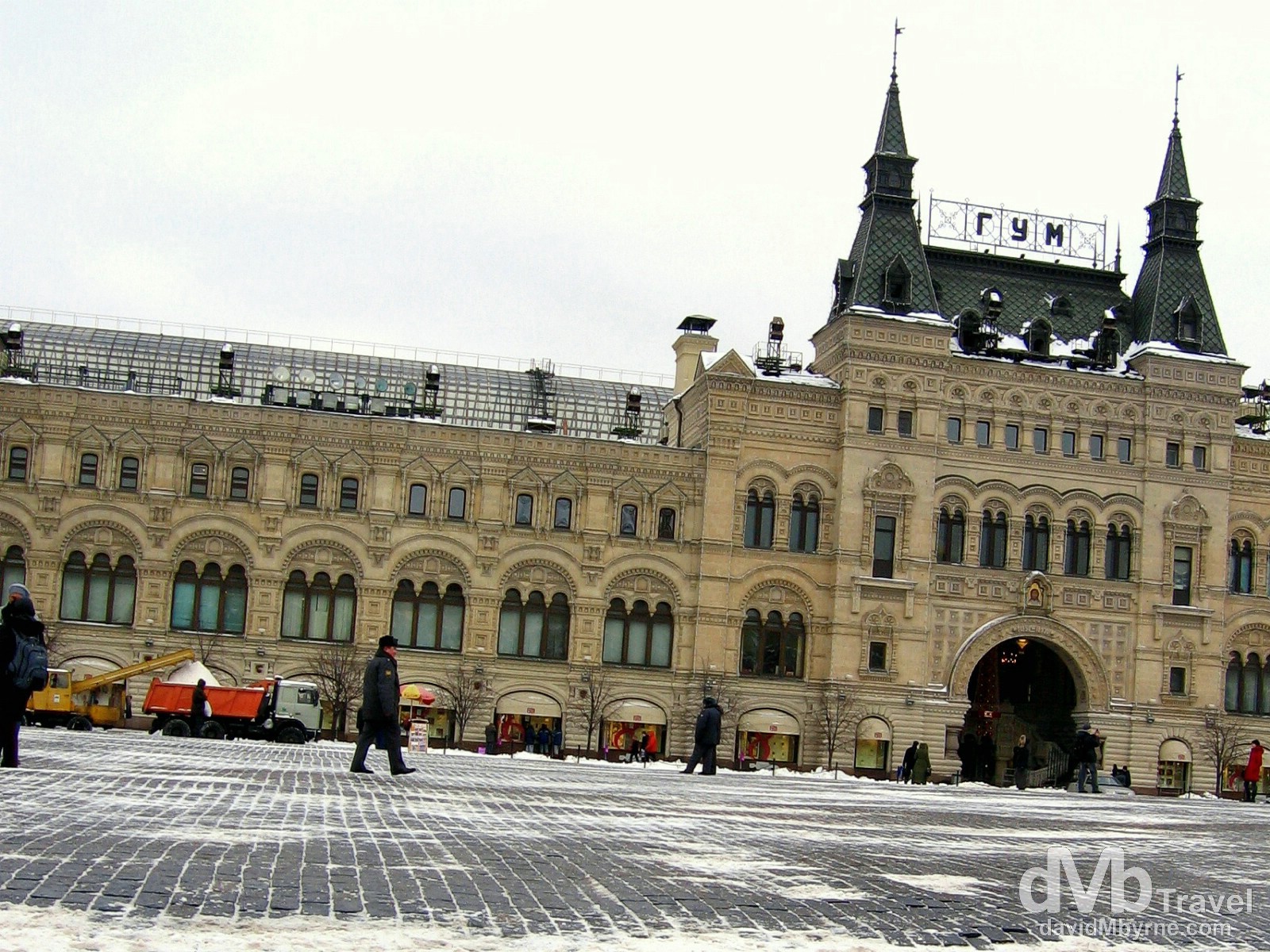
And so back to Red Square. The main square is off-limits until 1 p.m. each day which coincides with the closing of Lenin’s Mausoleum – seemingly the restriction is a gesture to the greatness of the man, one held over from the days of communism. This photograph was taken mid-afternoon from the middle of the square with my back to the mausoleum. It shows the impressive GUM Department Store which lines the whole of the north-eastern side of the square, a massive baroque building that resembles more a 19th century train station than the bastion of capitalism it is today. The GUM Department Store as seen from Red Square, Moscow, Russia. February 26, 2006.
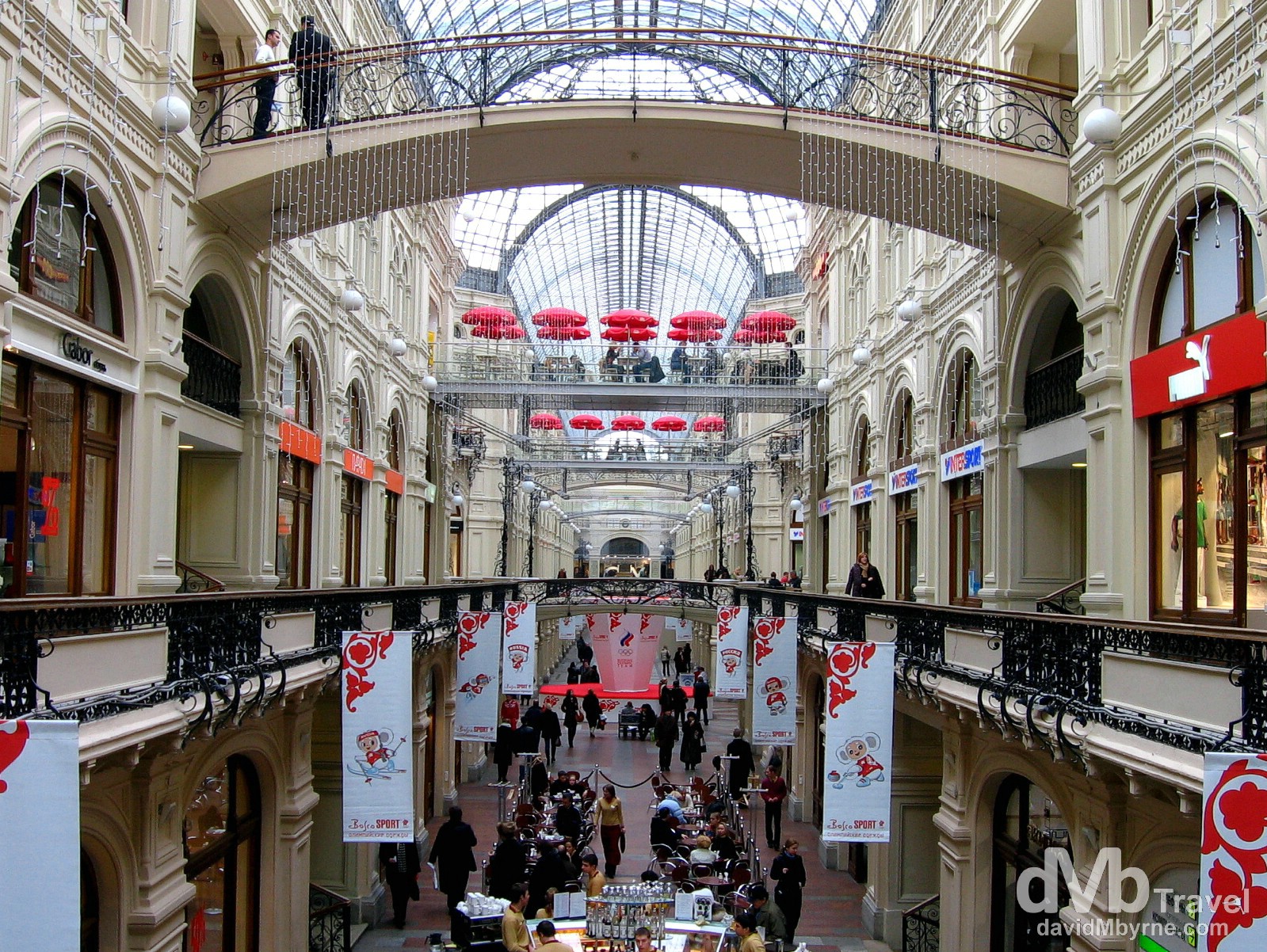
The GUM Department Store used to symbolise all that was wrong with Russia – long lines of starved locals queuing for overpriced and rationed food (for the lucky few). But now it’s Moscow’s largest store, boasting an elegant turn-of-the-century interior that comprises three parallel arcades centered on a fountain and overlooked by galleries. Light floods in through the building’s glass roof and the souvenir stands, foreign stores and designer boutiques cater to the ‘new rich’, of which there are plenty in the city – Moscow boasts more billionaires than any other city in the world. GUM Department store, Red Square. Moscow, Russia. February 26, 2006.
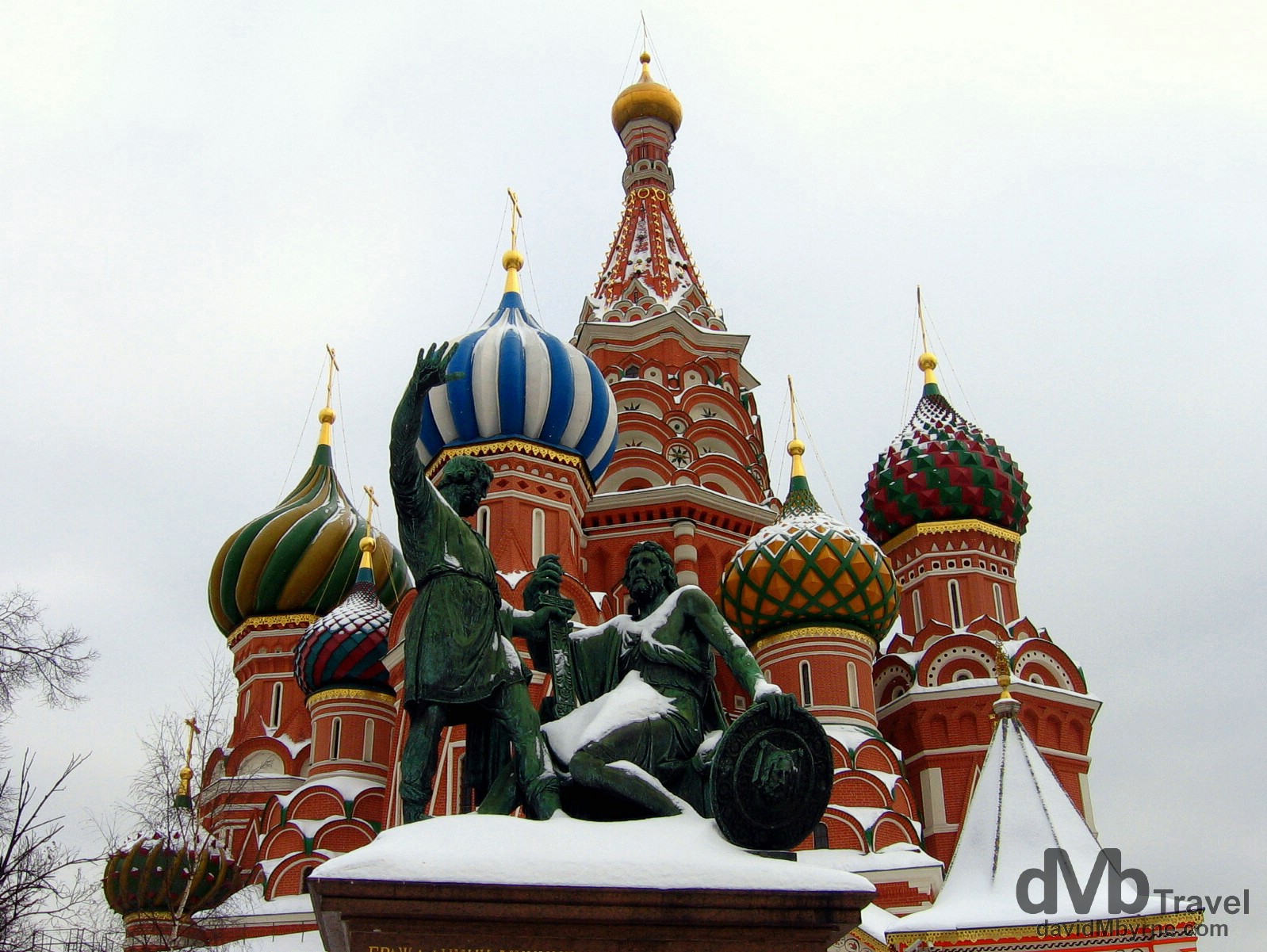
St. Basil’s Cathedral is a multi-tented church, a fanciful explosion of pinnacles, onion domes, and spade-shaped gables that is probably Moscow’s most recognisable landmark and a symbol of Russia. Commissioned by Ivan IV, aka Ivan the Terrible, it was built between 1555 and 1561 to commemorate the capture of a foe, the Khanate of Kazan. Ivan was so keen to immortalise the victory that he blinded the architects after the cathedral’s bright onion domes were completed to ensure nothing of comparable beauty could ever be built. Although not particularly large it does consists of nine chapels built on a single foundation. The bronze statues seen here fronting the cathedral commemorate Dmitry Pozharsky and Kuzma Minin, who rallied Russia’s volunteer army against the Polish invaders during a period called ‘The Time of Troubles’ in the late 16th and early 17th centuries. The statue was originally constructed in the center of Red Square but the Soviet government felt it obstructed parades and so in 1936 they moved the statue to its present location in front of the cathedral. St. Basil’s Cathedral, Red Square, Moscow, Russia. February 26, 2006.
______________________________________________________________________
